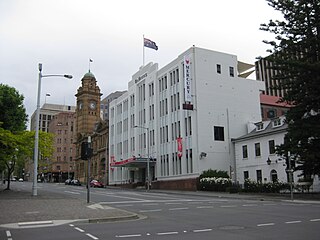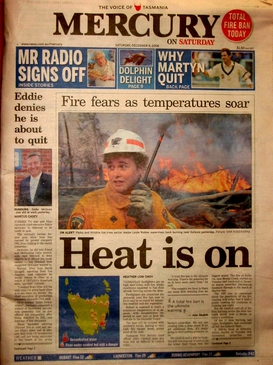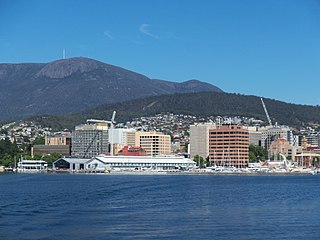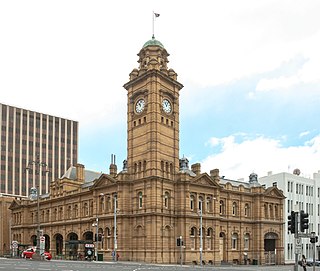The history of Tasmania begins at the end of the most recent ice age when it is believed that the island was joined to the Australian mainland. Little is known of the human history of the island until the British colonisation in the 19th century.

Sullivans Cove is on the River Derwent adjacent to the Hobart City Centre in Tasmania. It was the site of initial European settlement in the area, and the location of the earlier components of the Port of Hobart.

Davey Street a major one way street passing through the outskirts of the Hobart City Centre in Tasmania, Australia. Davey street is named after Thomas Davey, the first Governor of Van Diemen's Land. The street forms a one-way couplet with nearby Macquarie Street connecting traffic from the Southern Outlet in the south with traffic from the Tasman Highway to the east and the Brooker Highway to the north of the city. With annual average daily traffic of 37,200, the road is one of the busier streets in Hobart.

Macquarie Street a major one way street passing through the outskirts of the Hobart City Centre in Tasmania, Australia. Macquarie street is named after Lachlan Macquarie, who oversaw the planning of Hobart’s inner city grid layout. The street forms a One-way couplet with nearby Davey Street connecting traffic from the Southern Outlet in the south with traffic from the Tasman Highway to the east and the Brooker Highway to the north of the city. With annual average daily traffic of 28,500, the road is one of the busier streets in Hobart.

Evandale is an historic town in northern Tasmania, Australia. It sits on the banks of the South Esk River, 18 km south of Launceston. Named after early colonial explorer and Surveyor-General George Evans, the town is famous for its late-Georgian and early-Victorian buildings with relatively untouched streetscape, a popular Sunday market and as a host to the annual World Penny Farthing bicycle Championships. At the 2016 census, Evandale had a population of 1,345.

TheMercury is a daily newspaper, published in Hobart, Tasmania, Australia, by Davies Brothers Pty Ltd (DBL), a subsidiary of News Corp Australia, itself a subsidiary of News Corp. The weekend issues of the paper are called Mercury on Saturday and Sunday Tasmanian. The current editor of TheMercury is Craig Warhurst.

The Tasmanian Museum and Art Gallery (TMAG) is a museum located in Hobart, Tasmania. The museum was established in 1846, by the Royal Society of Tasmania, the oldest Royal Society outside England. The TMAG receives 400,000 visitors annually.

FitzGerald's Department Stores (FitzGerald's) was Tasmania's largest chain of department stores. The chain was rebranded and relaunched as Harris Scarfe in 1995, and the renamed stores continue to trade today.

Hobart City Centre is a suburb surrounded by metropolitan Hobart, which comprises the original settlement, the central business district, and other built-up areas. It is the oldest part of Hobart and includes many of the city's important institutions and landmarks, such as Parliament, the Supreme Court, Franklin Square, the Elizabeth Street Mall, the Royal Hobart Hospital, the Theatre Royal, Odeon Theatre, State Library, the NAB Building, the Museum, and the Cenotaph. The city centre is located in the local government areas of the City of Hobart.

Parliament Square is a historic city block, located directly behind the Tasmanian Parliament House in Hobart, Tasmania. It is presently under redevelopment, and upon completion will include Marriot International hotel, seven retail spaces, state government office building and plaza.

The Hotel Grand Chancellor Hobart is a twelve-storey hotel located on the waterfront of Hobart, Tasmania, Australia.

Franklin Square is a 1.6-acre (0.63-hectare) oak-lined public square located in the Hobart City Centre in Tasmania, Australia. It is named for Sir John Franklin, a renown Arctic explorer and former Lieutenant-Governor of Van Diemen's Land. The centrepiece of the park is a statue of Franklin, with an epitaph written by Alfred, Lord Tennyson. As the city's most central urban parkland and transportation hub, Franklin Square is frequently utilised for festive markets, public gatherings and as a place for public protest.

Henry Hunter (1832–1892) was a prominent architect and civil servant in Tasmania and Queensland, Australia. He is best known for his work on churches. During his life was also at various times a state magistrate of Tasmania, a member of the Tasmanian State Board of Education, the Hobart Board of Health, a Commissioner for the New Norfolk Insane Asylum and President of the Queensland Institute of Architects.

The ICON Complex is a low rise building in Hobart, Tasmania, situated in the city's centre. ICON Complex has access on two main street fronts, Murray and Liverpool. The Myer department store is situated on Liverpool Street, replacing the Myer lost on the same site in 2007. The Liverpool Street site consists of the ICON Complex shopping centre, boasting many national and international brands including MECCA MAXIMA and Scotch and Soda (Clothing).

Liverpool Street is a street in the Hobart City Centre, in the state of Tasmania.

General Post Office is a landmark building located on the corner of Elizabeth Street and Macquarie Street in Hobart, Tasmania, Australia. It stands next to the former Mercury Building and has served as the headquarters of the Tasmanian Postal system since its construction in 1905, though mail processing has now been moved to Glenorchy.

Ingle Hall is a landmark building in Hobart, Tasmania on the corner of Macquarie and Argyle Streets. It has served numerous purposes over its history and is vacant; it was most recently used as The Mercury print museum. It is unknown when the building was built as it predates any government record holding by the state of Tasmania, which began in 1822. It is named for John Ingle, one of the two possible first inhabitants of the building.
Brisbane Street is a street in Hobart, Tasmania. The street was named for Sir Thomas Makdougall Brisbane, the sixth Governor of New South Wales.
The Prince of Wales Theatre was a theatre on Macquarie Street, Hobart, Tasmania from 1910 to 1987.















